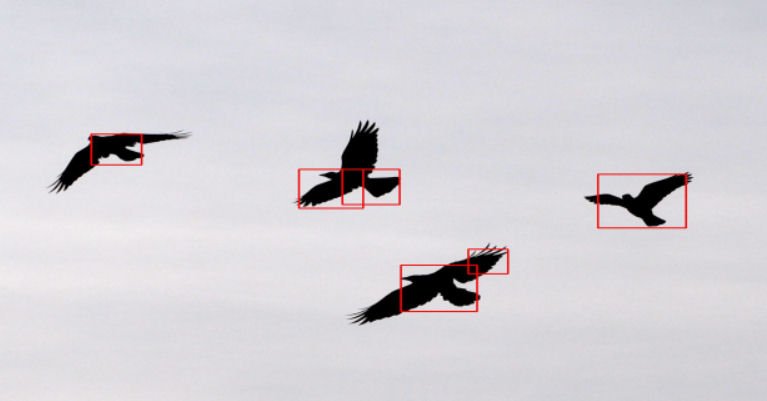
By Douglas Esser
Researchers counting University of Washington Bothell’s famous crows might take a photo of them. Now, a capstone project by electrical engineering students takes counting crows into the cloud for real-time analysis.
Image: Software identifies and counts the number of crows in the image. The red boxes indicate software has identified crows.
Associate Professor Pierre Mourad came up with the idea of taking photos of crows with a camera on a quadcopter drone, sending the images wirelessly to the cloud using a cell phone connection, and using image analysis software to send in-flight results to the researchers.
Four electrical engineering students made it their capstone project. Sponsored by the University and Microsoft, team members Virak Kong, Toan Nguyen, David Tan and Dong Tran showed the feasibility.
“The idea is more than reasonable,” said faculty mentor Wayne Kimura, affiliate assistant professor. “I think it foretells a new capability where the Internet of Things and the computational power in the cloud can be integrated with any device, be it a quadcopter, in your car or in your home.”
This project also involved Doug Wacker, assistant professor in biology, and Prasantha Jayakody, who represented Microsoft and gave critical technical assistance.
“Cellular Network Camera for Biology Research,” was one of eight presented Friday, March 11, by electrical engineering students who also had their posters on display in Discovery Hall.
Graphic: Images of crows recorded by the camera on the quadcopter are wirelessly transmitted to the cloud where they are analyzed. The information is transmitted back to drone operators who can see the results on their laptop.

Four more electrical engineering students found a way for the Snohomish Public Utility District to save money: cut transmission lines. That’s not realistic, they conceded as their project validated the software the utility uses to deliver electricity the most efficiently.
The utility district sponsored “Optimization of Power Cost Forecasting,” and the team of Sharon Brown, Anh Le, My Pham and Nhat Tran. They developed an algorithm to test whether the utility’s software maximized the power flow at the least cost without overloading lines.
“The students found that by disconnecting certain power transmission lines, they could save money; however, their industrial mentor later explained that this would also reduce the reliability of the grid,” Kimura said.
The students had to learn about the electrical grid and power distribution in a real world scenario — valuable career experience. They also exercised non-technical skills such as working with a customer, coordinating team members, delegating tasks and meeting deadlines.
“In mentoring the students, I often see them start as uncertain, somewhat bewildered students and, at the end of the two-quarter capstone course, leave as confident engineers,” Kimura said. “Thus, one might say the capstone course helps the students transform into true engineers. As an added benefit, their capstone project also looks great on their job resumes.”
Some students in other departments have capstone portfolios to sum up their work. Others also have capstone projects. Some capstones take all year and culminate in the spring quarter.
For example, the School of Interdisciplinary Arts and Sciences reports Interactive Media Design groups have several projects in progress:
• A point-and-click space adventure game that is inspired by teen stress and anxiety.
• An interactive art installation that incorporates live plants as the interactive mechanism (touch the plant and things happen).
• An endless runner game that draws attention to issues of male body image.



